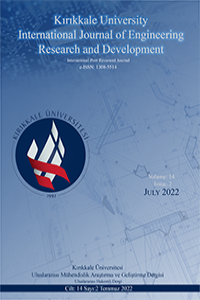Abstract
In this study, it was aimed to produce to domestic and less costly alümina based ceramic filters to be used in casting process and as an alternative to SiC foam filters. Two different polyurethane sponges at 8-10 PPI were used in this application, by choosing the replication method. Different suspension recipes have been prepared for ceramic filter. The sintering regime was determined by analyzing the TG/TDA. After sintering, the samples were examined by using optical microscope for mesh and pore size. The phases of samples were determined by using XRD analysis. Finally, the samples were tested in metal casting process. The costs of the samples found suitable were compared with the SiC filters.
Keywords
Cermic foam casting filter alümina polyurethane sponge replicaton
References
- Aydin T., (2018). Development of porous lightweight clay bricks using a replication method, J Aust Ceram Soc., 54:169–175
- Aydin T., (2019). The development of porcelain foams lighter than water for heat isolation application, Journal of Thermal Analysis and Calorimetry volume 136, pages535–539
- Çalışkan, F., Yılmaz, F., & Tatlı, Z. (2015). Silisyum Karbür Esaslı Seramik Köpük Filtre Üretimi. ISITES2015 Valencia -Spain
- Jaunich, H., Aneziris, C. G. ve Hubalkova, J. (2004). Innovative filter and feeder approaches for advanced metal casting technologies. Interceram Refractories Manual, 18-21.
- Tarhan M, Tarhan B, Aydin T. (2016) The effects of fine fire clay sanitaryware wastes on ceramic wall tiles. Ceram Int. 42:17110–5
- Cam WM, Senapati U. (1998) Porcelain-raw materials, processing, phase evolution, and mechanical behaviour. J Am Ceram Soc. 81(1):3–20.
Abstract
Bu deneysel çalışmada döküm prosesinde kullanılmak üzere ve SiC esaslı seramik köpük filtrelere alternatif olarak yerli ve daha az maliyetli alümina esaslı seramik filtre üretmek amaçlanmıştır. Yöntem olarak replikasyon yöntemi uygulanarak 8-10 PPI’da iki farklı poliüretan süngerler kullanılmıştır. Seramik filtre denemeleri için farklı süspansiyon reçeteleri geliştirilmiştir. Replikasyon yönteminde kullanılan sünger için TG/DTA analizi yapılarak sinterleme rejimi belirlenmiştir. Sinterleme sonrası elde edilen numuneler Optik Mikroskop ile ağ yapısı ve gözenek büyüklükleri karakterize edilerek incelenmiştir. Yine numunelerin XRD analizleri yapılarak oluşan fazlar belirlenmiştir. Sonuçta numuneler metal döküm işleminde test edilmiştir. Uygun bulunan numunelerin maliyetleri SiC filtreler ile karşılaştırılmıştır
Keywords
Seramik Köpük Döküm Filtre Alümina Poliüretan sünger Replikasyon
References
- Aydin T., (2018). Development of porous lightweight clay bricks using a replication method, J Aust Ceram Soc., 54:169–175
- Aydin T., (2019). The development of porcelain foams lighter than water for heat isolation application, Journal of Thermal Analysis and Calorimetry volume 136, pages535–539
- Çalışkan, F., Yılmaz, F., & Tatlı, Z. (2015). Silisyum Karbür Esaslı Seramik Köpük Filtre Üretimi. ISITES2015 Valencia -Spain
- Jaunich, H., Aneziris, C. G. ve Hubalkova, J. (2004). Innovative filter and feeder approaches for advanced metal casting technologies. Interceram Refractories Manual, 18-21.
- Tarhan M, Tarhan B, Aydin T. (2016) The effects of fine fire clay sanitaryware wastes on ceramic wall tiles. Ceram Int. 42:17110–5
- Cam WM, Senapati U. (1998) Porcelain-raw materials, processing, phase evolution, and mechanical behaviour. J Am Ceram Soc. 81(1):3–20.
Details
| Primary Language | Turkish |
|---|---|
| Subjects | Materials Engineering (Other) |
| Journal Section | Articles |
| Authors | |
| Publication Date | July 31, 2022 |
| Submission Date | May 24, 2022 |
| Published in Issue | Year 2022 Volume: 14 Issue: 2 |
Cited By
Seramik Esaslı Köpük Filtreler ve Uygulamaları: Kısa Bir Derleme
Osmaniye Korkut Ata Üniversitesi Fen Bilimleri Enstitüsü Dergisi
https://doi.org/10.47495/okufbed.1303257
All Rights Reserved. Kırıkkale University, Faculty of Engineering and Natural Science.


